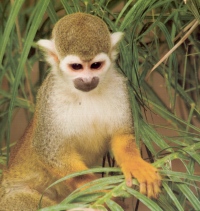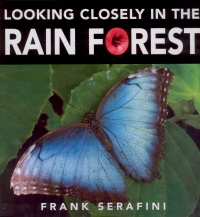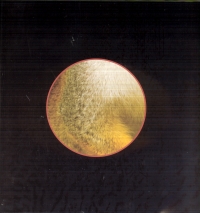| ________________
CM . . .
. Volume XVII Number 3. . . .September 17, 2010
excerpt:
Designed to arouse a childís curiosity about the natural environment, this book, the sixth of a series, takes readers on a journey of discovery through a rain forest habitat. Author-photographer Frank Serafini believes that looking closely at a natural object causes people to become more aware and that awareness leads, hopefully, to an understanding and an appreciation of nature and a desire to protect our fragile environment.
Questions and answers are given on alternate double-page spreads. Nine natural objects are featured: a squirrel monkey, a hibiscus flower, a red-eyed tree frog, a banana plant, a zebra tarantula, a scarlet macaw, a bamboo plant, a moth orchid and a spiny-tailed iguana. The book ends with a double-page spread- a photograph of the rain forest habitat showing the various layers of vegetation. The sharp details and vivid colours of the photographs are sure to appeal to readers.  Though the incredibly beautiful photographs steal the show, the accompanying information will certainly enhance one's enjoyment of the books and will, perhaps, inspire readers to take a closer look at the many wondrous works of nature in any habitat. Though the incredibly beautiful photographs steal the show, the accompanying information will certainly enhance one's enjoyment of the books and will, perhaps, inspire readers to take a closer look at the many wondrous works of nature in any habitat.
Highly Recommended. Gail Hamilton is a recently retired teacher-librarian in Winnipeg, MB.
To comment
on this title or this review, send mail to cm@umanitoba.ca.
Copyright © the Manitoba Library Association. Reproduction for personal
use is permitted only if this copyright notice is maintained. Any
other reproduction is prohibited without permission.
NEXT REVIEW |
TABLE OF CONTENTS FOR THIS ISSUE
- September 17, 2010.
AUTHORS |
TITLES |
MEDIA REVIEWS |
PROFILES |
BACK ISSUES |
SEARCH |
CMARCHIVE |
HOME |

 Through the magic of marvelous close-up photography, Serafini shows readers some detailed characteristics of a variety of plants and animals. In each case, he poses a question, in poem form, and offers two choices. For example, "Look very closely. What do you see? Sand dunes? Pussy willow? What could it be?" Readers are challenged to examine a portion of a photograph before guessing. On the next page, Serafini reveals the photograph in its entirety and provides brief general information about the plant or animal.
Through the magic of marvelous close-up photography, Serafini shows readers some detailed characteristics of a variety of plants and animals. In each case, he poses a question, in poem form, and offers two choices. For example, "Look very closely. What do you see? Sand dunes? Pussy willow? What could it be?" Readers are challenged to examine a portion of a photograph before guessing. On the next page, Serafini reveals the photograph in its entirety and provides brief general information about the plant or animal.